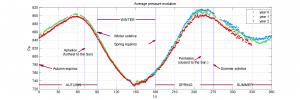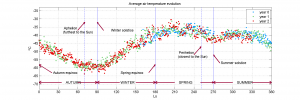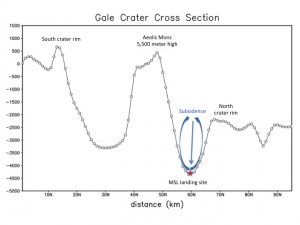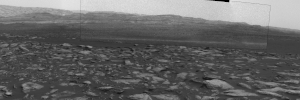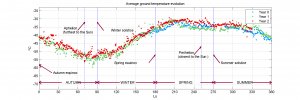Jorge Pla-García, Antonio Molina, Javier Gómez-Elvira and REMS team
The eleventh month of the thirty-third Mars year [1] goes from sol [2] 1582 to 1631 since the Curiosity landing. According to the Sun position, this month goes from 300 to 330 solar longitude [4] (Ls). The rover drove uphill along half a kilometer (482 m) and climbed 17 meters in elevation on Aeolis Mons [3] –an average slope of 3.5%– during these 49 sols. Although the rate of ascent was similar to last month, Curiosity diverted its course to study Ireson Hill. Even a small relief as this one worth separate from the path, since it may provide valuable information about Gale’s past geologic and environmental conditions (see Figure 1). One of the main reasons to climb Aeolis Mons is precisely that: it is a time travel, looking into the results of millennia of activity. The rising in elevation is also interesting from an atmospheric point of view, and time still goes on, being the second summer month –of three– in the southern hemisphere.
Figure 1. Two drawings depict the same location on the northern half of Gale Crater at two points in time. North is to the left and central peak to the right. (Source: NASA/JPL-CALTECH) Click here to know more.
Atmospheric dust
This month the atmospheric dust is in the spotlight. The spring equinox (Ls 180) is the starting of the “dust season,” as the solar radiation reaches its maximum, and it will end with the autumn equinox (Ls 0). Dust is highly influential in the Martian atmosphere causing most of its variability. The particle size is so small that we could say it is smoke dust instead. The suspended dust particles have a double effect, retaining the infrared radiation coming from the ground but reflexing the incident visible radiation, providing an anti-greenhouse effect in this case. Because of that, nighttime temperature rises, while the daytime temperature decreases. The result is a reduction in the day temperature range, both ground and atmospheric, of about 20 °C. These changes in temperature have a substantial effect on pressure and winds that modify the transport and injection of dust on the atmosphere, feeding back the process.
Atmospheric pressure
The atmospheric pressure continues dropping during this month, similarly to the last one (Figure 2). As the autumn equinox approaches, the CO2 in the atmosphere starts to freeze over the southern polar cap, decreasing the air pressure. As expected, the atmospheric pressure is lower this month compared to the same month of previous years, since the rover is climbing Aeolis Mons –the higher the elevation, the lower the air pressure.
Figure 2. Average pressure evolution measured by REMS instrument inside Gale crater (Source: CAB) Click image to enlarge.
The highest daily air pressure is registered during the sunrise and the lowest during the sunset due to the Mars thermal tides [6],as we talked about last month.
Air temperature
Temperatures were below zero during all the month, something common on Mars. The average temperature was around -42 °C, with an average daily maximum of almost -9 °C, while the minimum was around -69 °C (Figure 3). It is important to note, however, that the temperatures above 0 °C are rare, oscillating every day about 60 °C –more in a single sol than the annual daily average.
A higher dust concentration compared to last month caused a raising in the minimum daily averages –more greenhouse effect for the ground emitted infrared radiation during the night– and a decrease in the maximum daily averages –anti-greenhouse effect for visible radiation during the day.
Figure 3. Average air temperature evolution measured by REMS instrument inside Gale crater (Source: CAB) Click image to enlarge.
As it is noted in Figure 3, temperatures were very similar to the ones recorded the same month of the lasts years.
Atmospheric Circulation
This month ends the annual atmospheric behavior that we called “ventilation” or high mixing –that we explained in detail last month. The mountain waves [8] that inundated the crater with air from the outside start to weaken, so the mixing between inside and oustide air is becoming slower.
Due to the crater’s topography, the wind rises through the rims during the day and sink again during the night, as can be seen in Figure 4. This local circulation is called subsidence and occurs in Gale as well. The flows divert near the surface and converge again over the crater, suppressing the lower layer of the atmosphere, named as CLA [4].
CLA’s height is related to the topography, the surficial roughness, the wind speed, and the temperature difference with the ground, among others factors. During the daytime, the increase in temperatures and vertical air mixing widens the CLA. On the other hand, during nighttime, the cooling of the ground stop convection decreasing turbulence (thermodynamic, not mechanic one!) and CLA gets thinner.
Curiosity continues its journey upslope Aeolis Mons [3], getting further from the maximum subsidence zone (red star in Figure 4). The higher over Aeolis Mons, the more winds will flow (downslope during nighttime and upslope during daytime) and the higher the air temperatures –since the cold air masses trapped inside the crater stay behind.
Figure 4. Atmospheric subsidence of air masses inside Gale Crater. (Data source NASA/Goddar) Click image to enlarge.
Dust devils
Dust devils are common both on Earth and Mars surface. The intense solar radiation heating of a spot on the ground, that gets hotter that its surroundings, produces a turbulent convective process. The hotter air mass close to the ground floats creating a pressure depression below it. The low-pressure area pulls the air around it in, generating winds that rotate and rising dust within it (Figure 5). Dust devils have a major role controlling the suspension dust, as they are the primary dust injectors.
Figure 5. This sequence of images shows a dust-carrying whirlwind, called a dust devil, scooting across the ground inside Gale Crater at Sol 1597 (Source: NASA/JPL-Caltech/TAMU). Click here to know more.
During the first and second year since the arrival of Curiosity, the CLA was very weak (thin or suppresed), limiting therefore the turbulences reach and dust devils formation. The higher we are on the rims of Aeolis Mons, the stronger (wider) is the CLA, allowing the creation of more dust devils. As expected, Curiosity observed much more of them, like the one in Figure 5.
Ground temperature
This month the ground temperatures have been less constant that during the past one, recording a light decrease, but still being around -35 °C in daily average (Figure 6). As solar radiation is highly influenced by the seasons, this is an expected trend. The variability in the daily averages is something that is also repeating from last years during this month, highly influenced by suspension dust and the diversity in grounds along the Curiosity track. Rims, as Ireson Hill, favor the existence of mixed materials with different thermal behavior.
Figure 6. Evolution of the ground temperatures measured by REMS instrument inside Gale crater (Source: CAB) Click image to enlarge.
Thanks to REMS team for their effort and the valuable data.
Glossary
[1] In an arbitrary convention, April 11th 1955 was adopted as the beginning of Mars year 1, because it was the year before the global dust storm of 1956, the first one to be investigated in detail. Also, 1956 was an International Geophysics Year and that it had the best Mars “opposition” for the previous 15 years. A year on Mars lasts twice as long (687 Earth days) because Mars is farther away from the sun and has to travel a greater distance around it.
[2] Sol is a martian day, that lasts 24 hours and 40 minutes (in terrestrial time). The sol number is the number of sols since the Curiosity rover landed in Gale crater.
[3] Aeolis Mons is the central mound inside Gale crater, also known informally as Mount Sharp in memory of the American planetary geologist Robert P. Sharp.
[4] Solar longitude is commonly referred to as Ls, this is the angular position of Mars relative to the Sun measured in degrees from the summer equinox (start of northern hemisphere Spring). The Ls year is divided into 360 fractions (degrees).
[5] The main component of the martian atmosphere is CO2, so the atmospheric pressure is mostly influenced by the total mass of this gas above the surface. The CO2 is seasonally stored in the poles as an ice cap overlying another ice cap made of water (and dust).
[6] Thermal tides occurs when sunlight heats the surface and atmosphere on the day side of the planet, causing air to expand upwards. At higher levels in the atmosphere, this bulge of air then expands outward, to the sides, in order to equalize the pressure around it. Air flows out of the bulge, lowering the pressure of air felt at the surface below the bulge. The result is a deeper atmosphere, but one that is less dense and has a lower pressure at the surface, than that away from the subsolar point. As Mars rotates beneath the sun, this bulge moves across the planet each day, from east to west. A fixed observer, such as REMS, measures a decrease in pressure during the day, followed by an increase in pressure at night.
[7]CLA is the lowest layer of the Mars atmosphere, where turbulenence air mixing predominates due to friction with the rough ground surface and the convective rise of air bubbles.
[8] Thermsl inertia is the the measure of how quickly or slowly an object gains or loses heat to its environment.

